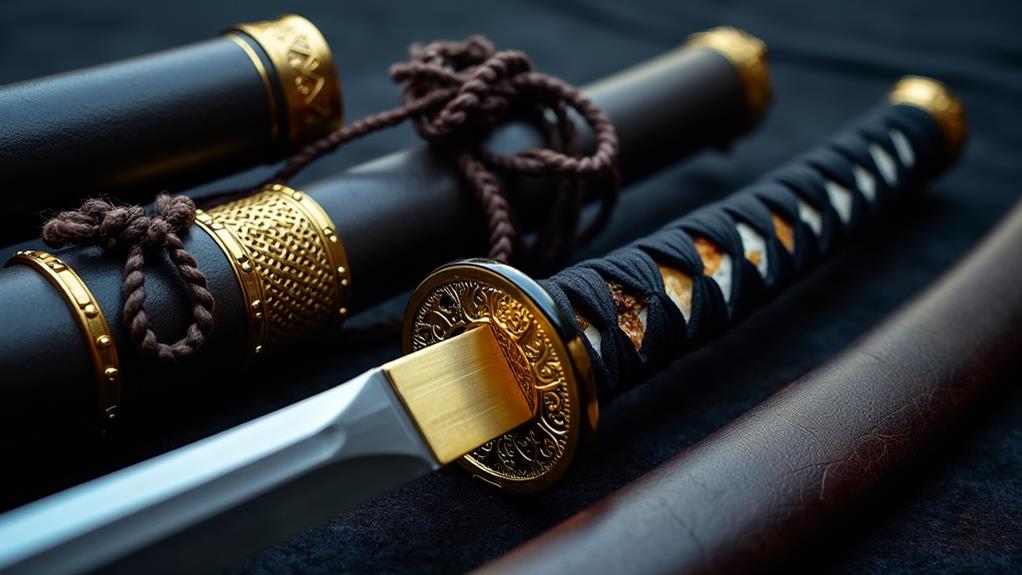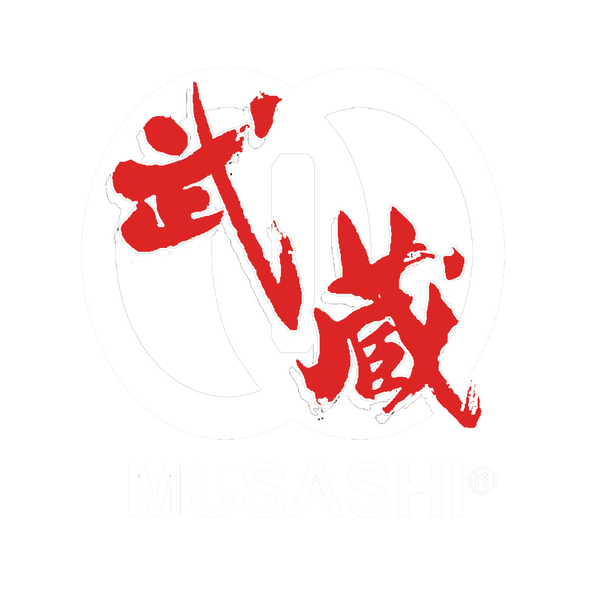
Sword accessories, including sageo and menuki, enhance both the function and look of your blade. The sageo secures the scabbard and lets you express your personal style, while menuki improve your grip and showcase unique designs. Each menuki can symbolize different meanings, like good fortune or strength. The tsuba adds safety and intricate artistry, while the saya protects the sword and reflects craftsmanship. You can also choose the perfect stand to display your sword's story. Each accessory connects you to a rich tradition and enhances your sword's meaning, so there's plenty more to explore.
Key Takeaways
- Sageo secures the scabbard, showcasing personal style and cultural significance through color and knot types.
- Menuki enhance grip while conveying symbolic meanings, adding charm and artistry to the sword's handle.
- Tsuba ensures safety during use and features intricate designs with rich cultural significance reflecting craftsmanship.
- Saya, crafted from lightweight wood and often lacquered, protects the sword while providing aesthetic appeal in various finishes.
- Selecting the right sword stand involves considering size, weight, and personal taste to securely display the sword.
Importance of Sword Accessories
The significance of sword accessories lies in their dual role of enhancing both functionality and aesthetics. When you're handling Japanese swords, each element—like the battle wrap, menuki, and tsuba—plays a crucial part in your experience. The sageo, for instance, secures the scabbard, allowing you to carry your sword with pride. This cord reflects not just your personal style but also your martial arts affiliation, fostering a sense of belonging within the community. Additionally, sword accessories are deeply connected to the spiritual and cultural meaning of the samurai and their ideals.
The menuki, those decorative ornaments on the grip, provide more than just visual appeal; they improve grip and handling while conveying deep symbolic meanings in Japanese culture. Similarly, the tsuba, the hand guard of your samurai sword, guarantees your safety while showcasing intricate designs that speak to the craftsmanship behind each blade.
The careful selection of these accessories grants you the chance to complete the katana ensemble, honoring the tradition of Japanese swordsmanship. Each piece, including the elegant ray skin on the handle, contributes to the functional beauty of your sword, making it a true extension of yourself. Embracing these accessories connects you to a rich history and the artistry behind the craft.
Exploring Sageo Variations
While pondering the aesthetic and functional aspects of your sword, exploring sageo variations can reveal a world of personal expression. The sageo isn't just any cord; it's a crucial accessory that brings a unique touch to your Samurai Japanese sword, reflecting the craftsmanship and artistry reminiscent of the katana's forging process. With options that enhance both the beauty and craftsmanship of your blade, you'll find that the right sageo can make all the difference.

Color Choices: Sageo comes in various colors, from traditional black and brown to vibrant variations. Choose one that complements your sword and reflects your style.
Knot Types: The way you tie the sageo can hint at your martial arts background or social status, adding another layer of meaning to your sword's presentation.
Length and Design: Longer sageo, up to 3 meters, are ideal for ceremonial displays. Intricate braiding and ornate patterns not only serve aesthetic purposes; they create visual appeal that speaks to collectors and enthusiasts alike.
Each sageo you choose tells a story that connects you to the rich history of Japanese warriors, as seen in the significance of katana.
Understanding Menuki Designs
Menuki designs play a pivotal role in the character of your Japanese sword, blending functionality with artistry. These decorative ornaments are embedded into the handle (tsuka), adding charm and meaning to your katana. Menuki enhance your grip and represent significant cultural symbols, making them both functional and aesthetic.
Here's a glimpse of popular menuki designs:
| Design | Symbolism | Materials |
|---|---|---|
| Cloud and Moon Motifs | Serenity and peace | Brass, stainless steel |
| Grasshopper and Cricket | Good fortune and prosperity | Silver, brass |
| Raptor Feather Patterns | Strength and nobility | Stainless steel, brass |
| Ginkgo Leaf | Endurance and resilience | Blackened stainless steel |
Menuki are often crafted from materials like brass, stainless steel, or silver, and they're positioned to complement the overall aesthetic of your sword. Whether you choose piece with brass menuki in the Musashi Ko-Katana or the moon-shaped menuki of the Ginkgo Leaf Katana, these symbolic and decorative menuki resonate with a sense of belonging and tradition. Embrace the art!
Craftsmanship of Tsuba and Fittings
Tsuba and fittings add another layer of artistry and significance to your Japanese sword, complementing the menuki designs. Each piece tells a story, showcasing the dedication of skilled craftsmen. Traditionally made through meticulous techniques, these components aren't just for protection; they enhance the overall balance and aesthetic of your sword.

The tsuba, for example, not only safeguards your hands but also features intricate designs that often symbolize deeper cultural meanings, showcasing the unique craftsmanship seen in the blade components of a katana.
- Tsuba: The handguard that features intricate designs, such as the Koi and Seaweed Motif from the Edo period, reflecting status and artistry.
- Fuchigashira: The top mount of the wooden scabbard, contributing not just to appearance, but functionality as well, guaranteeing the sword fits securely and can be drawn smoothly.
- Washers Used: These small yet crucial components guarantee the durability and stability of fittings, playing an overlooked role in the martial arts experience.
Whether you're practicing or displaying your sword, the craftsmanship of tsuba and fittings connects you to a legacy of tradition and artistic expression. It's in these details that the true spirit of your sword is revealed.
Saya Materials and Styles
The saya, or scabbard, plays a vital role in both the protection and presentation of your katana. When you choose a saya, consider its materials and styles carefully, as they greatly influence your sword's overall aesthetic and durability.
Typically, the saya is crafted from lightweight, dry wood, often lacquered for enhanced protection against rust. This lacquer not only keeps your high-carbon steel blade safe but also adds a polished visual appeal that enhances the beauty of your Japanese katana. Understanding the significance of the blade quality is indispensable, as it complements the saya's role in maintaining the sword's integrity.

You'll find saya available in various finishes, ranging from natural wood to stunning, hand-carved designs that showcase fine craftsmanship. For those looking for extra sophistication, high-quality saya may feature water buffalo horn accents, lending both elegance and practicality. These components protect your blade while elevating its presentation, making your katana a true centerpiece.
To maintain the saya's condition and extend its lifespan, proper care and storage are vital. By selecting the right saya, you connect with the rich tradition of sword making, ensuring your katana remains a cherished artifact with both beauty and purpose.
Selecting the Right Sword Stand
Choosing the right sword stand is crucial for displaying your katana in a way that highlights its unique craftsmanship. The stand you select can make a world of difference in how your sword is perceived. It's all about stability and security, guaranteeing your katana is supported safely while also complementing its beauty.
Three key considerations to help you choose the perfect stand:
- Style: Decide if you prefer a minimalist floor stand for highlighting the katana's elegance or a more ornate wall mount for a touch of historical grandeur.
- Size and Weight: Ensure the stand matches the dimensions of your katana, providing practical considerations for secure display.
- Personal Preferences: Think about the story you want to tell. Your stand should reflect your taste and what your sword means to you.
Frequently Asked Questions
Why Did Shogun Carry Two Swords?
You carry two swords to embody sword etiquette and cultural significance, showcasing sword craftsmanship and aesthetics. Their maintenance reflects honor, while ceremonial sword use emphasizes your status and connection to samurai tradition, fostering belonging in this rich heritage.
Why Do Japanese Carry Two Swords?
You appreciate the historical significance of carrying two swords, mastering sword etiquette, and embracing sword care practices. This connection to tradition enhances your identity, as you participate in sword maintenance techniques and ceremonial rituals, fostering a sense of belonging.
What Is the Purpose of the Menuki on a Katana?
Menuki enhance your katana's grip, adding decorative purposes and cultural significance. They embody historical development and identification of the owner, contributing to balance and handling, while showcasing your weapon's unique artistry and connection to tradition.
Conclusion
In final analysis, sword accessories enhance not just the beauty of your blade but also its functionality. Choosing the right sageo, menuki, and tsuba can reflect your personal style and make your sword unique. Understanding the materials and designs helps you appreciate the craftsmanship involved. Whether you're displaying your sword or using it, selecting the right accessories adds value and character to your collection. Embrace these elements to fully enjoy your sword's artistry and heritage. For high-quality sword accessories and authentic Japanese blades, Musashi Swords offers an extensive selection to complement your collection.


